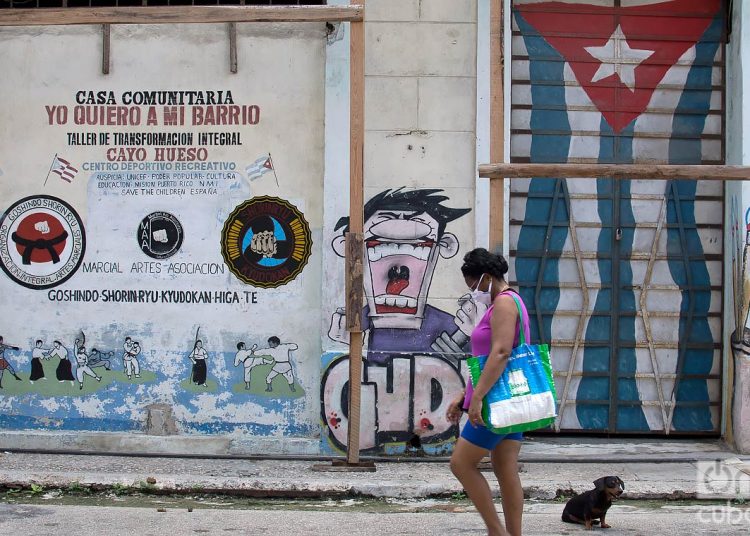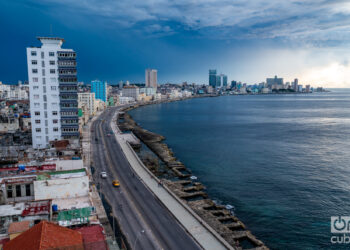It seems obvious that you can’t look ahead without noticing where you are, and what is around you. In the Cuban case, this exploration is equivalent, as Rubén Matínez Villena would say, to an “exercise of brave discipline” to overcome the avalanche of perorations, opinions and counter-opinions that saturate the environment, and obscure the process of political change underway, in itself complicated.
Now that the 8th Party Congress is less than eight months away, it is worth analyzing some of the ideas that have inspired the policy of reforms, a decade later. Instead of emulating with the accumulation of recommendations to the government that circulate in the networks, some very reasonable, this brief analysis is aimed at examining the real policy on its own terms, to appreciate how far it has come from today’s perspective, to not only count the pending agreements, but to estimate to what extent it has been consistent with its logic, and how it is explained.
Almost 10 years ago, the central themes of the 6th Congress, collected in the headlines of those Guidelines of the economic and social policy of the Communist Party of Cuba and the Revolution, were reflected in the frequency of certain key words. Approved after public debate in its eighth version, among its most frequent terms were “decentralize” and its related words (“decentralized,” “territory,” “territorial,” “local” and “municipal”), recurring 50 times; “non-state,” almost 30; “cooperative” or “law” and their related words, more than 20. That vocabulary revealed an agenda and emphasis quite alien to mere continuity.
The 6th Congress (April, 2011) and then the First Conference of the PCC (January, 2012) criticized “the superficiality and formalism with which political-ideological work is carried out, the use of outdated methods and terms that do not take into account the level of instruction of the Party members,” the great obstacle that “the mentality that, as a psychological barrier, is the one that will be the hardest to overcome since it is tied to obsolete dogmas and criteria” represented for the initiated changes; the bad practice leading to the fact that “the Party at various times has been involved in tasks that do not correspond to it,” in particular, the “replacing of functions and decisions that correspond to the government and administrative institutions”; the tendency among many leaders to “the non-use of governing documents of the organization” and “the lack of rigor in the analysis and the consequent non-application of the policy outlined.”
To this list of evils were added, among others, “the slowness in the search for solutions to the dissimilar problems that must be faced on a daily basis, as well as little creativity, poor links with the masses, lack of a demanding attitude in the face of violations and indiscipline, leadership bureaucratic methods, and the consequent loss of authority and exemplarity motivated by negative attitudes, sometimes corrupt.” The “negligence, nepotism and double standards, as well as lies and accommodating ways” in the behavior of some leaders were denounced.
Those events in 2011 and 2012 called for “the broadest and sincerest exchange of opinions, both within the Party and in its relationship with the workers and the people” and “the expression of diverse ideas and concepts, so that discrepancies are assumed as something natural.” They demanded that social communication, particularly with young people, be “more creative, systematic, grounded.” They promulgated that the concepts and style of work with the mass organizations (unions, women, students, neighbors and farmers) be reviewed, based on “respect for their democratic and autonomous functioning.” They underscored the Party’s responsibility to “demand and verify that the institutions and the Party itself pay timely and due attention to complaints, denunciations and other issues raised by the population and that answers be provided with the required rigor and speed.”
Compared to the density of ideas that questioned the functioning of political institutions, and with the frequency of the terms mentioned, some others were notoriously scarce. For example, in the draft of the Guidelines publicly discussed, the issue of poverty and the specific reference to the role of trade unions were conspicuous by their absence, as was that of social science. Among the 313 approved guidelines, only 11 spoke of “science” and only one of “social science.” Despite its aloneness, Guideline 137 characterized, for the first time, the role of the social sciences in understanding the country’s problems and in producing policies to address them.
Nine months later, the First Conference of the PCC adopted 100 objectives, among which six were dedicated to the role of the social sciences, notable for their conceptual and political charge. If the reader does not remember any, despite the fact that they were published, it is probably because this is the most ignored and relegated document of all those produced by the reforms.
Without space here to transcribe them, or what to say to comment on them, I will limit myself to referring to the text that includes the work objectives of the PCC, published on January 29, 2012, and to briefly mention some of its headlines. Among these, social research is identified as basic for making decisions, evaluating social impacts and conceptualizing the model. The formalism, routine and anachronism of the communication and propaganda media are questioned; the poor reflection of the complex real society, of its social and economic differences, of gender, color, religiosity, sexual orientation and regional origin; the slowness, lack of transparency and imbalance in information on the country’s problems, the “secrecy” and the relegation of the population’s needs. They guide these media to seek support in scientific studies, to be more open to culture and debate, analysis and public opinion, and to aim at having a news, objective and investigative journalism. To the schools, that they update their theories with the problems of the present and with the debate of ideas.
If sufficient progress had been made in the direction of these objectives, their effect on the functioning of the political system and the public sphere would have implied a turnaround in those other areas of politics that affect the economy and social development. The zeal to prevent the reforms from being read as renouncing socialism has clouded understanding of the political and ideological changes that characterize the transition. Paradoxically, the more it has been emphasized that the changes undertaken since 2011 are “only” economic and social, the greater has been the weight of the new political, ideological and cultural codes in their underlying dynamics. The more there has been talk of the “new economic and social model,” the greater the space dedicated by Raúl between 2006 and 2018 to criticize the bad ways of leading and the problems in the functioning of the political system, to the imperative need to decentralize, for economic reforms to advance, to overcome anachronistic ideological formulations and to combat the “old mentality,” which is nothing more than bureaucratic inertia.
Since the changes do not only concern the establishment of a mixed economy, the conceptualization of the new model became more urgent. The palpitation of this demand has been felt not only in the public debates on the main reform documents, including the new Constitution, or in the often raucous exchanges that overwhelm the networks, but also in the zigzags and instabilities of the policies.
Some commentators did not understand the usefulness of the Conceptualization of the model for political and economic practice. They saw it as “more of the same” in ideological terms, if not a “leap backwards,” as it did not embrace “the Chinese and Vietnamese path” or that of “good social democratic capitalism.” However, this has been the document closest to a project of new socialism demanded by many. Commenting on its central ideas and also its shortcomings would take more space than I have here, but I will return to them later.
A bird’s eye view of the 7th Congress (April 2016) would allow us to identify some outstanding milestones. Of the 313 articles or tasks of the Guidelines approved in 2011, barely a fifth had been completed five years later. However, the Congress not only reaffirmed the project of a socialism with mixed economy, but also legitimized, for the first time, the concept of small and medium-sized enterprises, called SMEs by experts. Unnoticed by most international commentators, and in line with the proposals of numerous Cuban social science researchers for two decades, this agreement advocated legislation that would distinguish between small-scale activities, typical of family micro-businesses (a peanut vendor) and those who hire workforce (the owner of one or several businesses with dozens of employees), in fact, a small or medium-sized entrepreneur, who worked legally with a “self-employment” license.
To end this article with a topic in vogue at that time, and which is now less and less spoken of, I will refer to the leadership replacement. When this issue is referred to, it is usually dated to the election of a new government, in 2018, under the new Constitution. Thus, the complexities that this change entails in an institutional system such as the Cuban one are underestimated, and the preceding changes in the leadership of the Party at all levels are forgotten.
The 7th Congress was a fundamental step in the process. The five new members of the Political Bureau not only lowered the average age from 70 to 63, but also increased the presence of women from one to four. Two of them were not Party cadres, nor were they there representing women, but rather key areas of science: the computerization of society and the production of medicines.
In that Political Bureau there was for the first time a Minister of Health and a Foreign Minister, together with a Minister of Economy, all under 60 years of age, elected for their professional status, as well as three of the four military who sit in this body, all in command positions of the Armed Forces. Also for the first time, the number of members for their professional status exceeded those of professional political leaders at this level.
Most of the professional political cadres elected to the Political Bureau came from leading in the provinces during the previous 15 years. At the provincial level, both the Party and People’s Power leaders were under 50 years of age. The average age of the elected Central Committee was lowered from 59 to 54 years; the already high presence of women and blacks and mulattos increased, as well as the composition of economics and science professionals. Instead, the representatives of higher education and culture were reduced; as well as MINFAR and MININT, from 14% to 9%.
These figures measure the replacement of people who occupy positions within existing state and political institutions, surely much higher than that characterizing those same apparatuses when elections and government changes take place in other countries. However, the transition in Cuban socialism encompasses much more than the replacement of leadership.
In other countries, the change, if there is one, consists of electing a new government, which must adopt measures inspired by a certain platform, especially economic and social policies, according to a certain existing constitution. Seen by some commentators with those same eyeglasses, the new Cuban government seems to have devoted its energies to something simple called “the transition of power” and has “neglected its main banner, the political, social and economic program.” This approach does not realize that the political effectiveness of a government program, whatever it may be, does not depend on simply stating it and formulating it, but on implementing it and finally applying it. In this process, policies “come down” from the decision-making centers to local spaces, where it is executed and carried out, experiencing a certain degradation, suffers setbacks called interpretations, or is directly blocked.
Now, reducing the transition in Cuba to the replacement of leadership, and that change of people at the top of the state and political power apparatuses, does not allow us to understand the scale of the transformation underway, including that of the political class, its nature, mindset and leadership style.
It is not, of course, a matter of seeking justifications for what has been postponed over and over again, or of rationalizing the inertia of institutions, but of identifying and understanding the nature of the ongoing change. This change requires that totally or partially renewed institutions, in terms of the people who integrate them, transform what psychologists call their “organizational culture,” their way of functioning, their style of government. Or as Martí said, their “command habits.”
To what extent does the accelerated and deepened crisis caused by COVID-19, more than the results in the next U.S. elections, force the transformation of these “command habits,” or reinforce them? In the answer, or rather, the siege of this question, the structural contradictions that the Cuban transition and its future are going through could be illustrated.










